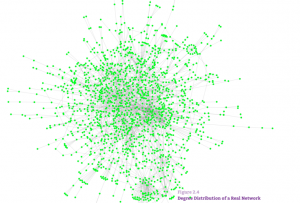NaviGap travel app is designed to facilitate interactions between networks of students travelling on their gap year and can be predicted and analysed using the mathematical language of graph theory in order conceptualise it in more abstract terms by representing individuals within the network as nodes and the relationship or connection between users as links (Barabasi 2002).

ALBERT-LÁSZLÓ BARABÁSI
A number of graph theory metrics can be utilised in analysis of the social network, for example, Degree centrality which measure the number of links (connections) into/out of the node (user) which gives an indication of the users’ influence and popularity by measuring node connectedness. Those users with more connections have a higher centrality and therefore can reach more people.
Users of NaviGap as they make use of the functionality, would be grouped together by their connections which would help to facilitate strong clustering between travelling companions and/or regular information seekers and providers.
An effect observed by Kossinets & Watts (2006), found that a shared focus (i.e. a community of travellers with a shared goal/ location) gives more opportunity for the formation of strong social connections or strong ties between people which results in increased levels of social capital. This can be defined in terms of frequency of interactions between pairs of users, reciprocity of communication, and the interaction type. We believe that fostering strong clustering will benefit users in providing more relevant information and in building traveling companion relationships making the travel experience more rewarding and potentially safer. This may be of value to socially / geographically isolated students that wish to embark on a gap year.
References:
Barabasi, A. L. L. (2002). The New Science of Networks. Cambridge, MA: Perseus Books.
Coleman, J. S. (1988). Social capital in the creation of human capital. American journal of sociology, S95-S120.
Kossinets, G., & Watts, D. J. (2006). Empirical analysis of an evolving social network. science, 311(5757), 88-90.
